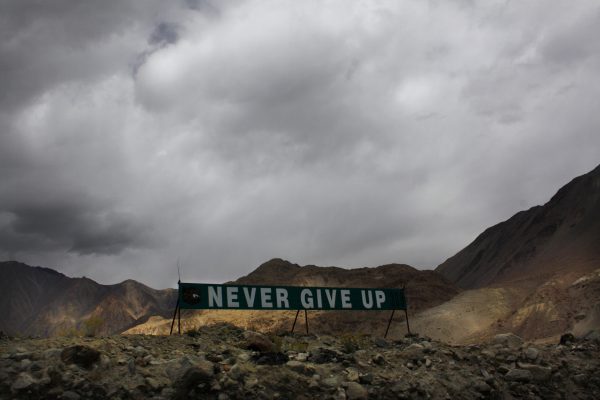The establishment of buffer zones in areas of disengagement is eating into territory formerly under Indian control.
In this September 14, 2017, file photo, a banner erected by the Indian army stands near Pangong Tso lake near the India-China border in India’s Ladakh area.
Six months after they stepped back on the north and south banks of Pangong Tso, Indian and Chinese troops have completed their disengagement from the Gogra area (Patrolling Point 17A) in eastern Ladakh.
“Both sides have ceased forward deployments in this area in a phased, coordinated and verified manner. The disengagement process was carried out over two days i.e. 04 and 05 August 2021,” a statement issued by India’s Ministry of Defense (MoD) said.
The two sides have dismantled “all temporary structures and other allied infrastructure” erected in the area and “troops of both sides are now in their respective permanent bases,” the statement added.
The agreement on pullback of troops in the Gogra area, which was reached at the 12th round of talks between Corps Commanders of the two sides held on July 31, “ensures that the Line of Actual Control (LAC) in this area will be strictly observed and respected by both sides, and that there is no unilateral change in status quo.”
However, there is no statement from Beijing relating to the troop disengagement.
Enjoying this article? Click here to subscribe for full access. Just $5 a month.
The pullback from the Gogra area is the third friction area from which soldiers of the Indian Army and the People’s Liberation Army (PLA) have disengaged so far to end the military standoff along the LAC, the de facto border between India and China, in Ladakh.
The standoff was triggered by China’s occupation of territory on the Indian side of the LAC at Depsang, Galwan Valley, Gogra-Hot Springs, and Pangong Tso in April-May last year.
Diplomat Brief Weekly Newsletter N Get briefed on the story of the week, and developing stories to watch across the Asia-Pacific. Get the Newsletter
It was at the start of a “partial disengagement” at PP14 at Galwan Valley that Indian and Chinese troops clashed violently on June 15, resulting in the death of 20 Indian soldiers and an unknown number of Chinese soldiers. The disengagement at Galwan was completed eventually in July.
It was followed by the second disengagement from the friction area at Pangong Tso-Kailash Range in February.
While the disengagement of troops from the three friction areas at Galwan, Pangong Tso, and Gogra is a welcome development, the process appears to be going to India’s disadvantage.
The two sides are reported to be establishing no-patrolling buffer zones in areas of disengagement but worryingly, these “buffer zones are largely coming up in what India claims to be its territory.”
This was the case at Galwan, for instance, where India and China agreed on a three-kilometer “buffer zone” on both sides of the LAC. This “buffer zone” eats more into Indian controlled territory than that which the Chinese controlled prior to April 2020. As a result, the LAC at Galwan has shifted “by one kilometer in favor of the Chinese.”
India has repeatedly weakened its own hand at the talks. Although defense analysts were drawing attention to Chinese occupation of territory on the Indian side of the LAC as early as May, the Narendra Modi government repeatedly denied this. Indeed, even after the Galwan clash, Prime Minister Modi was echoing the Chinese argument that the PLA had not intruded into Indian territory.
Then in February, while negotiating the disengagement of troops from Pangong Tso, the Indian side agreed to vacate from the heights in the Kailash Range on the south side of the Pangong Tso. It erred in doing so as its control of the Kailash heights gave it an advantage over the Chinese. By pulling back from these heights, India surrendered its sole bargaining chip too early in the disengagement process. It should have used this chip to get the Chinese to agree to pull back from Depsang.
With disengagement from Gogra done, the focus of the talks between India and Chinese military officials will move to PP15 at Hot Springs.
Enjoying this article? Click here to subscribe for full access. Just $5 a month.
However, it is securing disengagement at Depsang, which is likely to be the most challenging. Depsang’s strategic value to India and China is immense. India’s Daulat Beg Oldie airstrip is barely 20 kilometers from the Karakoram pass and is India’s lifeline to the Siachen glacier.
The Chinese have stubbornly refused to discuss disengagement from Depsang with India.
